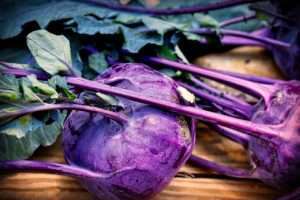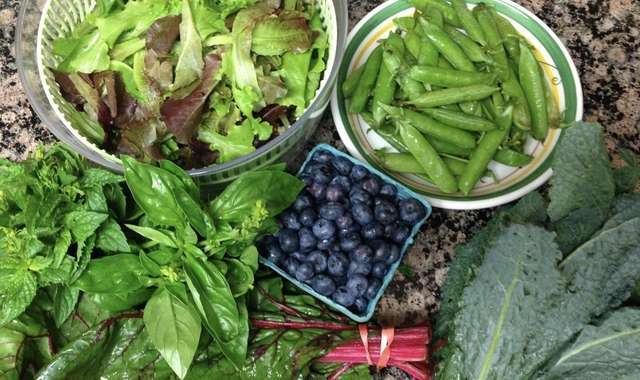By Sofia Perez
[Published by Zester Daily, September 2, 2014]

Alien life form or kohlrabi?
When I decided to join a community-supported agriculture (CSA) group last year, I had many reasons — first among them, my weekly share of gorgeous local produce from Free Bird Farm. But I also felt it was important to do what I could to help support an organic family farm and preserve agricultural land in upstate New York. As an environmentalist and food writer, I wanted to put my money where my mouth and pen were.
What surprised me, though, was how much more I gained in return. Beyond the wonderful produce and eggs and an even greater respect for seasonality, farmers and Mother Nature—something that, as the descendant of farmers, I already possessed—my CSA taught me many lessons, mundane and profound. Here are three.
The freezer is your friend
When I unpack my weekly CSA haul, I immediately start picturing all the fabulous dishes I can make from the colorful jewels before me. Never mind that the recipes I’m imagining usually require an army of kitchen assistants and a willful ignorance of the space-time continuum. I am not easily deterred, and I embark upon my fool’s errand with inordinate enthusiasm, until suddenly it is 10 p.m. and I do not know where my sous chefs are. (Oh, that’s right. I don’t have any.) How then to use up all these wonderful ingredients fast enough to beat the ticking spoilage clock?
When my CSA gave me kale last summer, I put it in the crisper drawer, where it promptly got buried under a deluge of greens. Upon rediscovering it several days later, it looked the way I feel after a long flight—wilted and dehydrated. Then the penny dropped. Hey, that really cold part of my refrigerator exists for a reason. Faced with other, more perishable leftovers in the queue for my next meal, and reservations to eat out the following day, I decided to trim and wash the kale leaves and store them in a freezer bag, where they were retrieved for smoothies the following week.
When the CSA gave me shelling peas, I removed them from their pods, froze them on a baking sheet and transferred them to a bag. Strawberries? Same thing. Parsley, basil and other herbs? I cleaned, chopped and blended them with olive oil, and poured the combination into ice-cube trays. (Warning: Don’t reach for the wrong cubes when you are mixing a gin and tonic.)
Not everything freezes well, but by storing those items that do, you’ll be liberated to focus on the “eat me now” diva ingredients instead. (I’m looking at you, tomatoes.)
How my CSA taught me to stop worrying and love kohlrabi
OK, maybe “love” is too strong a word. Of my relationship with this alien-looking vegetable, I’d have to say, “It’s complicated.” But when I joined the CSA, I promised myself I would tackle each ingredient at least twice. With kohlrabi, this meant roasting it the first time and slicing it into a type of coleslaw the next. I put forth the same effort for every item that I would not normally gravitate toward, such as radishes, turnips and broccoli.
Over the course of the season, I found myself thumbing through long-forgotten cookbooks or going online in search of inspiration. Not every dish that emerged from this exploration was a winner, and I still sometimes trade in the kohlrabi for a different vegetable in the swap box, but as in other facets of life, it’s been edifying to push myself out of my comfort zone. Being part of a CSA forced me out of certain kitchen ruts and helped me to discover delicious recipes—like roasted radishes—that I probably wouldn’t have tried otherwise.
When in doubt, tortilla
It’s great to experiment, but some nights all you want is dinner. When a pile of miscellaneous produce leaves me unmotivated, my go-to dish is Spanish tortilla. Though the classic version of this frittata-like omelet calls for potato, onion and eggs, you can build one around almost any vegetable-and-herb combination.
First, sauté your produce in olive oil to your preferred level of doneness. Beat the eggs in a large bowl, and add the sautéed vegetables, making sure to stir immediately so the heat doesn’t cook the eggs. Season with salt and pepper, toss in any herbs you’re using and pour the mixture into a non-stick or well-seasoned skillet. If you want to include cheese—which is not traditional, but tasty nonetheless—add it now.
The number of eggs you use will depend on the produce. For greens that release a lot of water (like spinach), add an extra egg to bind the combination. (In general, the mixture should be more liquid than solid, and it’s always safer to err on the side of additional eggs.)
When the top of the tortilla is firm around the edges and you’re able to lift it cleanly with a spatula, place a plate larger than the skillet face down over it. With a potholder on top of the inverted plate, flip the skillet so the tortilla transfers to the plate. (This maneuver will be terrifying the first few times you do it. Trust me, it gets easier. Until you master it, flip it over an easy-to-clean counter in case anything leaks out.) Slide the flipped tortilla back into the pan, cook it on the other side, and—¡olé!—dinner is served.
But just before you tuck into your meal, there’s one last step: Remember to give thanks for the local farmers who made it possible—in my case, Ken Fruehstorfer and Maryellen Driscoll.



